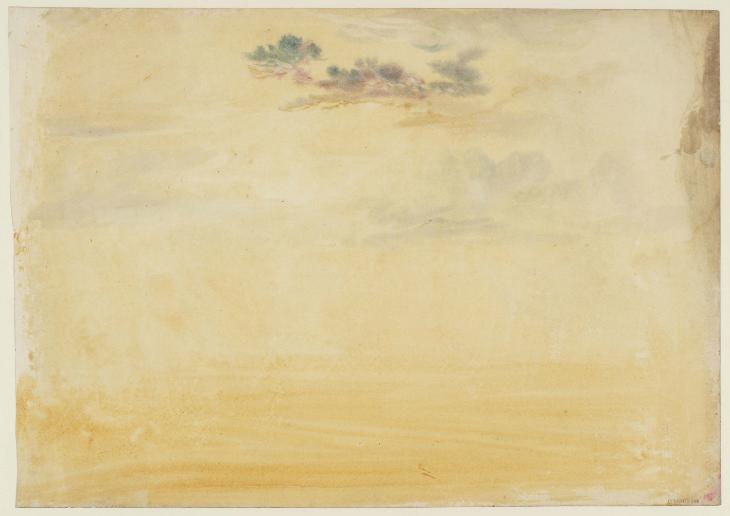Joseph Mallord William Turner High Clouds at Dawn or Sunset c.1815-30
Joseph Mallord William Turner,
High Clouds at Dawn or Sunset
c.1815-30
Joseph Mallord William Turner 1775–1851
High Clouds at Dawn or Sunset c.1815–30
D25259
Turner Bequest CCLXIII 137
Turner Bequest CCLXIII 137
Watercolour on white wove paper, 302 x 439 mm
Blind-stamped with Turner Bequest monogram towards bottom right
Inscribed in red ink ‘137’ bottom right
Stamped in black ‘CCLXIII – 137’ bottom right
Blind-stamped with Turner Bequest monogram towards bottom right
Inscribed in red ink ‘137’ bottom right
Stamped in black ‘CCLXIII – 137’ bottom right
Accepted by the nation as part of the Turner Bequest 1856
Exhibition history
1983
J.M.W. Turner: Dibujos y acuarelas del Museo Británico, exhibition catalogue, Museo del Prado, Madrid, February–March 1983 (65, as ‘Cielo de atardecer’, c.1825–30, reproduced in colour).
1986
Turner Exhibition, National Museum of Western Art, Tokyo, August–October 1986, Municipal Museum of Art, Kyoto, October–November (80, as ‘Evening Sky’, 1825–30, reproduced in colour).
1991
Turner: The Fourth Decade: Watercolours 1820–1830, Tate Gallery, London, January–May 1991 (29, reproduced, as ‘Study of a Sunset Sky’, 1825–30).
1997
Turner’s Watercolour Explorations 1810–1842, Tate Gallery, London, February–June 1997, Southampton City Art Gallery, June–September (7, as ‘A Colour Wash Underpainting, with Diffused Cloud Forms’, ?late 1810s to mid–1820s, reproduced in colour).
2007
Colour and Line: Turner’s Experiments, Tate Britain, London, April–November 2007 (no catalogue).
2007
Colour and Line: Turner’s Experiments [second hang], Tate Britain, London, November 2007–October 2008 (no catalogue).
2014
Making Painting: Helen Frankenthaler & JMW Turner, Turner Contemporary, Margate, January–May 2014 (17, as ‘A Colour Wash Underpainting, with Diffused Cloud Forms’, ?late 1810s to mid–1820s).
References
1820
A.J. Finberg, A Complete Inventory of the Drawings of the Turner Bequest, London 1909, vol.II, p.825, CCLXIII 137, as ‘An evening sky’, c.1820–30.
1991
Ian Warrell, Turner: The Fourth Decade: Watercolours 1820–1830, exhibition catalogue, Tate Gallery, London 1991, pp.11, 41 no.29, reproduced, as ‘Study of a Sunset Sky’, 1825–30.
1810
Eric Shanes, Turner’s Watercolour Explorations 1810–1842, exhibition catalogue, Tate Gallery, London 1997, pp.25, 38 no.7, as ‘A Colour Wash Underpainting, with Diffused Cloud Forms’, ?late 1810s to mid–1820s, reproduced in colour, pp.94, Appendix I, under ‘Diffused Seascapes and Skies’, 102, under ‘Sky Sketches’.
Finberg described this as an ‘evening’ subject, though it might alternatively be dawn, with the high clouds in silhouetted against the bright sky but touched with red, the effect heightened by the contrast with the golden glow of the overall wash,1 as discussed in the technical notes. Compare the similarly coloured clouds, also laid in ‘wet-in-wet’, in Tate D25259 (Turner Bequest CCLXIII 137).
In regarding this sheet as dating from the late 1820s, Ian Warrell has noted that such studies, with their ‘understanding gained through the kind of colour chiaroscuro’ seen here, informed the ‘richness’2 of the skies in paintings of the period such as Ulysses Deriding Polyphemus – Homer’s Odyssey, exhibited in 1829 (Turner Bequest, National Gallery, London),3 as well as informing the atmospheric effects of topographical watercolours in the Rivers of England and Picturesque Views in England and Wales series of the 1820s and 1830s.4
In the light of Finberg’s suggestion that this sheet is uniform with three others which may have come from a sketchbook (see the technical notes below), Eric Shanes has noted that one of them (Tate D25260; Turner Bequest CCLXIII 138) bears an 1811 watermark. Given the range of possible dates for a Yorkshire landscape identified among them (Tate D25255; Turner Bequest CCLXIII 133) from 1816 through to 1825 or later, Shanes and has discussed various possibilities regarding the present work ‘any time between the late 1810s and the mid-1820s’.5 He has compared the ‘idealised clouds’6 in paintings such as Dido Building Carthage, exhibited in 1815 (Turner Bequest, National Gallery, London),7 The Decline of the Carthaginian Empire, exhibited in 1817 (Tate N00499), 8 Dort, or Dordrecht, exhibited in 1818 (Yale Center for British Art, New Haven)9 and Entrance to the Meuse, exhibited in 1819 (Tate N00501).10 The generic default date of c.1820–40 noted in the Introduction to this subsection has thus been modified in this instance.
Warrell has noted this work as among those ‘grouped in a parcel of twenty sheets by John Ruskin when he was engaged in selecting watercolours to display at the National Gallery, and which he designated “Colour effects. Finer” ... presumably finer than many of the other unfinished private studies which he considered “valueless”.’11
Technical notes:
Finberg noted that this sheet, Tate D25255, D25260 and D25261 (Turner Bequest CCLXIII 133, 138, 139), respectively a landscape and two sky studies (addressed elsewhere in the present section), are all of the same dimensions and may have been leaves of a sketchbook.1 Stitch holes appear to be evident at the left-hand edge in this case. See the main entry above for the implications for dating.
Eric Shanes gives the present work as an example of Turner’s introduction of ‘marblings’ of colour over wet paper, as described apparently from first hand observation by the Victorian watercolourist William Leighton Leitch (1804–1883).2 Shanes elaborates that it ‘provides ... evidence of Turner’s controlled use of colour diffusion for underpainting purposes’:
Primarily the artist laid down an overall yellow wash into which he brushed further yellow at the bottom. Before the sheet was completely dried he then brushed in the mauve-blue cloud forms, plus touches of crimson and blue so they diffused even further into these colours. Some lines in the clouds were then possibly lifted out of the colour with the wooden end of the brush.3
Verso:
Blank; inscribed by John Ruskin in pencil ‘AB 93 P | O’ top left, upside down; inscribed in pencil ‘CCLXIII. 137’ bottom right; stamped in black with Turner Bequest monogram over ‘CCLXIII – 137’ bottom right.
Matthew Imms
March 2016
How to cite
Matthew Imms, ‘High Clouds at Dawn or Sunset c.1815–30 by Joseph Mallord William Turner’, catalogue entry, March 2016, in David Blayney Brown (ed.), J.M.W. Turner: Sketchbooks, Drawings and Watercolours, Tate Research Publication, November 2016, https://www

